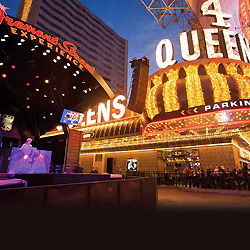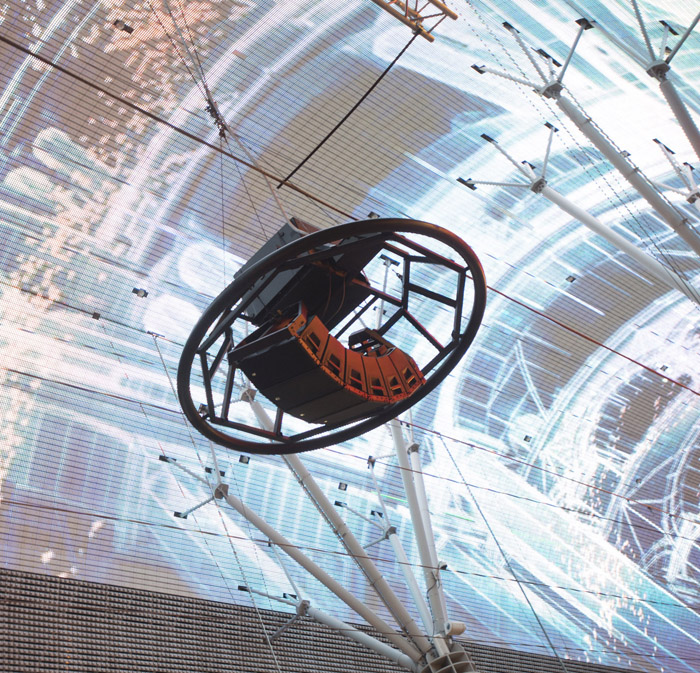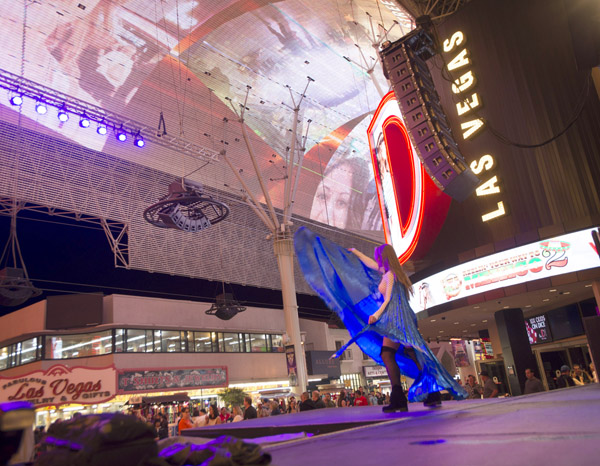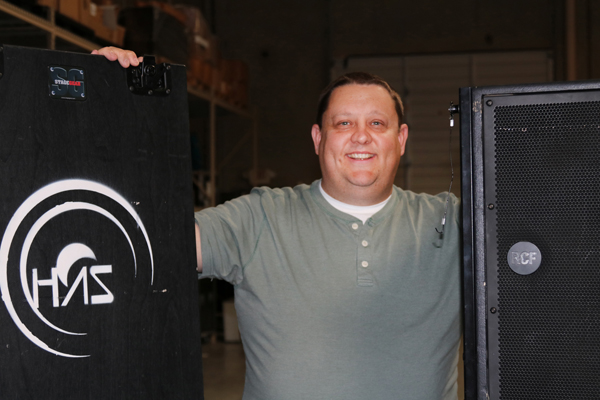
Paving The Way
The need for the upgrade was initiated by age-related issues bearing down on the existing system, which was beginning to deteriorate notably under the outdoor stress of the harsh, unforgiving desert environment.
Larry Hall of H.A.S. Productions (Las Vegas) served as the impetus for the project when he delivered 24 RCF boxes to the Main and First Street stages for installation.
“Larry has been a friend and a vendor of ours for years,” Pizzo notes. “Everyone loved the sound of the RCF boxes, and since we were in the process of sending a bid out for the upgrade, he helped us to find out if they were interested in participating in a demo.”
With some able direction coming from RCF USA national sales manager Tarik Solangi, the company put a demo together in front of the Main Street stage that rocked the mall and paved the way for the installation of the new RCF-based clusters.
As they are being installed right now, each cluster goes airborne using modified versions of the existing framework and rigging components built for its predecessors. A half-dozen RCF HDL 20-A enclosures are incorporated into each along with a single SUB 8005-AS subwoofer.
New sonic life is being injected into the three stages as well. When all is said and done, HDL 20-As will be on the Main and First Street stages, and TTL55 components will be on the Third Street stage. Subs on the stages include RCF TTL56s, AS-8006s and TTL36s; wedges are TT25-CXA models. DriveRack Venu360 boxes from dbx help orchestrate events on each riser, while mixing is a task given over to Soundcraft Si Performer 2 consoles obtaining signals with the aid of Soundcraft 32 x 8 MADI format compact digital stage boxes.

“We first put HDL 20-As into our First Street stage three years ago,” Pizzo relates. “We’ve thrown everything we have at them since then seven nights per week, 365 days per year, out there essentially hanging in the open unprotected, and they just keep going. Combine this with the fact that everyone loves the sound, and you’ll understand why we chose RCF for the rest of the mall as well.”
Being self-powered, the presence of the HDL 20-As in the 50 mall clusters have definitively brought to a close the old days on the street of crowded amp rooms and long loudspeaker cable runs. Within the previous system, 12-gauge wiring fed the clusters from conduit extending down to each cluster from the canopy. In an artful act of repurposing, Pizzo and the installation crew found it to be an easy enough task to pull back on that 12-gauge wiring and simply drop in the new 30-amp lines the design required.
“We have super-clean power up there right now,” Pizzo notes. “And we wired it right in. We were able to wire a backup circuit in too, just in case. But we don’t push the mall speakers that hard, at least not like at the stages, where we post 106 dB-SPL levels C-weighted for cover bands on any given night, and 105 A-weighted for headliners. That’s loud.”
Separate And Together
There are nights when headlining acts will play back-to-back on each of the stages. In a general sense, audio is usually compartmentalized to remain in the areas serving each of the stages, but there are other times when a show on the Main Stage, for example, will be broadcast visually down the entire canopy and the audio will follow suit a good portion of the way down the mall too.
To meet the challenges of controlling and distributing the audio so that it arrives where and when it’s supposed to and stays out of the areas it’s not intended to serve, a relatively simple blueprint was developed using a front end system based around a TiMax SoundHub.

Working in conjunction with a fiber-fed network of BSS London BLU-806 processors numbering five in total – one in the control room and four running down the length of the mall two per side – the TiMax SoundHub manages all playback and distribution, in effect telling the BSS boxes which cluster will get what levels at any given moment, and additionally providing the clusters with functions like delay when program material emanates from the stage. Audio is sent to and from the stage using BSS London BLU-326 processing.
“The way we set it up, it’s almost like a theatre application,” Pizzo says, giving the blueprint better illustration. “We wanted to make the system fully functional, yet keep it elegantly simple. On this level we’ve succeeded quite well. If you look around the control room, there’s really not a lot of space dedicated to audio. It’s 99 percent video. We come out of the TiMax SoundHub with Dante, that gets picked up by the first BSS box, and then it’s literally off to the races with whatever level of control and distribution we might need.
“There is very little audio processing going on,” he continues. “The four BSS processors out in the mall are fan-cooled, mounted about 30 feet up on columns. Dante travels via fiber to each, we convert back to Ethernet at each of those locations, and then have analog outs that we run to the clusters in either direction.”
The system was tuned using little more than a spectrum analyzer and good sets of human ears, with the resulting performance from the clusters resembling that of a constant curve type of array. “When we’re done it will be like a half-circle pattern that we’ve mounted in here,” to use Pizzo’s straight-to-the-point analogy. “Every one with a stake in this project listened to one another, and we really worked as a team to put it together. What we’ve created will take us well into the coming decades. Vegas, as a concept, is indeed constantly changing. Now we have the tools to deal with whatever comes our way both today and tomorrow.”
Gregory A. DeTogne is a writer and editor who has served the pro audio industry for the past 35 years.

